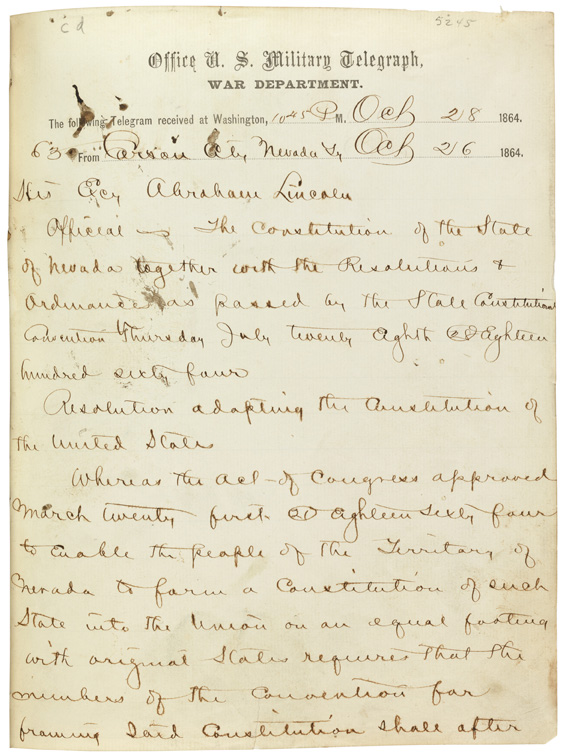
BIG! Celebrating the 75th Anniversary of the National Archives
Winter 2008, Vol. 40, No. 4
By Stacey Bredhoff
To celebrate a big anniversary—the National Archive's 75th—we will open a new exhibit featuring big records, big events, and big ideas. With the computer age in full swing, as viewers struggle to see documents and records on screens growing ever smaller, this exhibit will present the original record shown in its full-scale glory.
Starting with the 13-foot scroll of the Articles of Confederation—the first constitution of the United States—the items in the exhibit evoke the challenges, sacrifices, and even humor that are woven into the American tapestry. On the 75th anniversary of this institution, the National Archives presents pieces of the American story—writ large.
A section of an enormous map of the Gettysburg battlefield will be shown. Surveyed and drawn in 1868–1869, it comprises 20 sections and, fully assembled, measures approximately 13 feet by 13 feet. The map shows approximately 26 square miles of terrain in and around Gettysburg, Pennsylvania, site of the ferocious Civil War battle that raged from July 1 to July 3, 1863, and that many historians believe turned the tide of the war toward a Union victory.
With a scale of 1 inch to 200 feet, the map shows the names of area residents at the time of the battle, including the Bryan (Brian) family, who fled their 12-acre farm because, like other African Americans living in this area, they feared capture by Confederate soldiers. It reveals the terrain at the site of "Pickett's Charge," one of the great infantry charges in military history, where the Union held the high ground against the massive assaults by the Confederates. And it includes the site where President Abraham Lincoln delivered the Gettysburg Address, a rhetorical masterpiece in which he defined the war as necessary for the survival of the nation and its ideals.
In this exhibit, sometimes "big" means "long." Among the items is an icon of 20th-century diplomatic history: the "Long Telegram," sent in 1946 by George Kennan from the U.S. Embassy in Moscow to the Department of State in Washington, DC. Kennan, then deputy chief of mission, responded to an urgent communication from Washington, asking why the Soviet Union was refusing to join the World Bank. Kennan believed that the United States was clinging, mistakenly, to a wartime view of the Soviet Union as an American ally. He later recalled that he wrote "a preposterously long telegram some eight thousand words . . . describing, as though in a primer for school children, the nature, the ambitions, the calculations of [the Stalin regime.] It is a grim and uncompromising picture."
In the telegram, Kennan stated that Soviet expansionism had to be contained, and he established guiding principles to achieve that goal. It was a grand strategy of such prescience and incisiveness that it carried American-Soviet policy through 40 years of the Cold War to the ultimate collapse of the Soviet Union in 1991.
An even longer telegram—twice the length of Kennan's—was sent by the governor of the Nevada Territory to President Abraham Lincoln in October 1864. As part of the process of the Nevada Territory becoming a state, certified copies of the Nevada constitution were sent to Washington, DC, by overland mail and by sea. But when they had failed to arrive in Washington by October 24, Governor Nye ordered that it be sent by wire. With no direct link from Carson City to Washington, DC, telegrapher James H. Guild worked seven hours to transmit the message to Salt Lake City, where it was resent to Chicago, then Philadelphia, and finally to the War Department's telegraph office in the capital, where a 175-page transcription was made. The final page of the transcription, on view in the exhibit, shows the total word count (16,543) and cost ($4,313.27, or $59,229 in today's dollars). Three days after receiving the message—just eight days before the presidential election, Lincoln proclaimed, in accordance with an act of Congress, that Nevada was admitted into the Union, thus hoping to ensure his own reelection as well as the election of like-minded Republicans in Congress.
The exhibit highlights one of the biggest military personnel files preserved by the National Personnel Records Center in St. Louis, Missouri. Housed in nine boxes, the file of Gen. Douglas MacArthur chronicles a career that spanned half a century and ranged around much of the world. Flamboyant and controversial, MacArthur was one of the most highly decorated soldiers in the history of the military. He distinguished himself as a soldier in combat operations during World War I; he was the Supreme Allied Commander Southwest Pacific during World War II, the Supreme Commander of the Allied Powers during the postwar occupation of Japan, and Commander of the United Nations (UN) forces during the first nine months of the Korean War. Presented in the exhibit are a summary statement of his military service, the long list of decorations and service medals awarded him, and the April 11, 1951, telegram informing him that President Truman had relieved him of his command in Korea for making public statements that were critical of military and foreign policies of the U.S. Government. Also shown is the casualty report listing the death of General MacArthur in 1964 at age 84. A state funeral, previously planned in consultation with MacArthur himself, was held. With ceremonies that lasted a full seven days, it befitted the larger-than-life personality whom it honored.
As evidence that William Howard Taft was the biggest man to serve as President of the United States, the exhibit presents the 1909 order for a bathtub and other items specially ordered to accommodate Taft's 300-plus-pound frame. In January 1909, two months after being elected President (he was inaugurated on March 4, 1909), Taft boarded the USS North Carolina to set sail to inspect the Panama Canal construction zone. The ship was outfitted specially for him. The captain ordered the following items: "1 brass double bedstead of extra length; 1 superior spring mattress, extra strong; 1 bath tub, 5 feet 5 inches in length, over rolled rim and of extra width." Later newspaper accounts (and a photograph) revealed that the bathtub was built on an even bigger scale—that it had "pondlike dimensions . . . [it] will hold four ordinary men and is the largest ever manufactured . . . the tub is 7 feet 1 inch long, 41 inches wide and weighs a ton."
Soon after leaving the presidency, Taft lost 70 pounds, which he maintained throughout the remainder of his life. In 1921, Taft was appointed Chief Justice of the United States, becoming the only person to hold the highest office in both the executive and judicial branches.
The physical stature of basketball legend Shaquille O'Neal is one of the factors that makes him a powerhouse of an athlete. One of his shoes, presented to President George W. Bush as a gift, is on display. Rising up out of the size 22 Reebok, O'Neal—Shaq, as he is affectionately known by his fans—would stand tall at 7 feet 1 inch. Los Angeles Mayor Richard Riordan presented the shoe to President Bush in 2001, during his first visit to California as President; at the time, O'Neal was a star player for the Los Angeles Lakers. He has been voted one of the 50 Greatest Players in the history of the National Basketball Association. He now plays for the Phoenix Suns.
The exhibit includes the impression of a 200-million-year-old dinosaur track, made by a Eubrontes Gigantes—which would have stood approximately nine feet tall. It was made in 1970 by a teenage boy who had heard a news report about the discovery of dinosaur tracks in an abandoned quarry near his New Jersey home. He and his friend jumped on their bikes, went to investigate, and working on their own, uncovered thousands of fossilized dinosaur tracks, which experts later described as a "milestone . . . because of the large number of tracks." When they launched a successful campaign to preserve the site as an education park, they earned an official commendation from President Richard Nixon. One of those boys, Paul Olsen, is today one of the nation's foremost paleontologists, recently elected a member of the National Academy of Sciences. The impression of the dinosaur track that he made in 1970 was later sent to President Nixon and is among the holdings of the Nixon Library and Museum in Yorba Linda, California.
Finally, the exhibit pays tribute to an idea so big it engendered the birth of this nation. On July 4, 1776, a group of British colonists scattered along the Atlantic seaboard announced their separation from Great Britain with words that have inspired downtrodden people through the ages and around the world to rise up against their oppressors: "We hold these truths to be self-evident, that all men are created equal, that they are endowed by their Creator with certain unalienable rights, that among these are Life, Liberty, and the pursuit of happiness."
John Dunlap, the official printer for the Continental Congress, produced the first printing of the Declaration of Independence on the night of July 4–5, 1776, and delivered the copies to the Congress on the morning of July 5. The one that was inserted into the "rough journal" of the Continental Congress in the July 4 entry is included in the exhibit. It is one of the National Archives' greatest treasures. The handwritten version of the Declaration, later signed by members of the Continental Congress, is on permanent display in the Rotunda for the Charters of Freedom.
"BIG!—Celebrating the 75th Anniversary of the National Archives" will be on view in the National Archives Building, Washington, DC, in the Lawrence F. O'Brien Gallery from March 13, 2009, through January 3, 2010.


